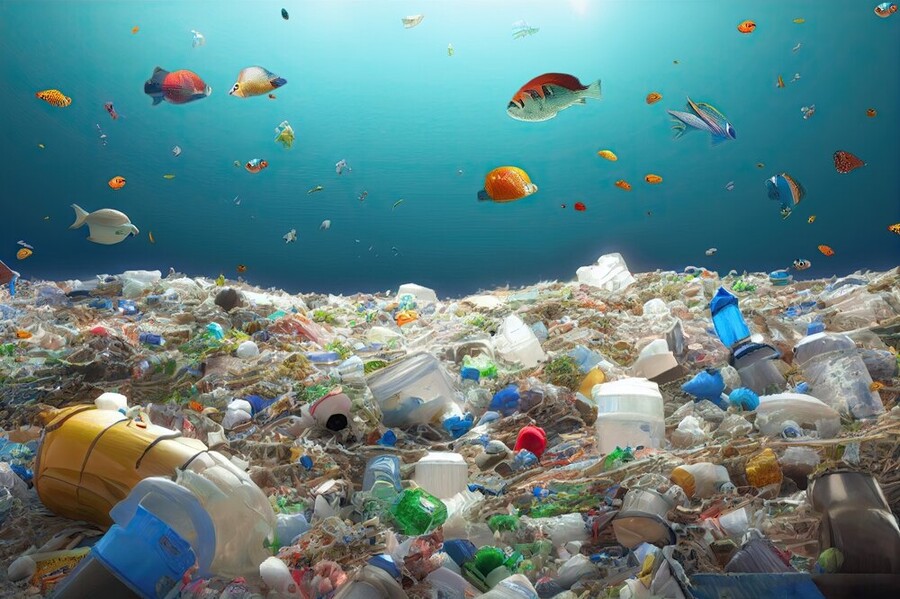Oceanic currents deposit enormous amounts of debris into an expansive area of the Northern Pacific Ocean sometimes called the Great Pacific Garbage Patch. Sailing through that gyre in 1975 was like wandering through a poorly-curated community yard sale with few treasures and lots of trash — mostly plastic. Thick then, it is worse now.
Most of the garbage originates on land and is dumped into waterways flowing to the sea, although some lost or abandoned fishing gear is also in the mix. Estimates of the amount of plastic entering oceans annually are highly uncertain and vary widely — from 500,000 metric tons to ten times that amount. Regardless, it’s a lot.
The International Union for the Conservation of Nature determined that plastic makes up 80 percent of all marine debris from surface water to deep sediments.
Rapidly growing volume of waste
According to a 2017 report from the Ocean Conservancy, most of the debris originates in several Asian countries where waste management frequently includes dumping plastic waste into rivers. But this focus on Asian countries diverts attention from major contributions of the United States, which is among the highest generators of plastic waste per capita in the world.
Plastic waste in the United States grew from less than ten million metric tons (MMT) in the 1980s to nearly forty MMT today. Only 5-6 percent is recycled. As much as half was historically shipped overseas where it often ended up in rivers. But those exports decreased when China and several other countries stopped accepting them.
Today, about 85 percent of plastic waste in the United States is landfilled and 10 percent incinerated. Exports are considered “recycling.”
Larger pieces of plastic polymers slowly break down into smaller fragments in marine, freshwater, and land-based environments. As they do, they attract wildlife who mistake them for food, ingesting pieces that can obstruct their intestinal tracts and kill them.
Micro- & nanoplastics are everywhere
But this isn’t the full extent of the problem. Even smaller microplastics (one micrometer to five millimeters in length) and nanoplastics (< one micrometer) are widely spread throughout the entire global environment, from pole to pole, the bottom of the sea to mountaintops, contaminating air, water, soil, and food chains.
Micro- and nanoplastics (MNPs) are continuously shed from consumer products during use, recycling, and after disposal. MNPs are even intentionally added to some personal care products.
MNPs raise significant health concerns since they can enter the body through inhalation, ingestion, and even skin absorption. They are composed of thousands of chemicals used in polymer and product manufacturing as well as chemicals that they absorb from the environment. They include toxic heavy metals, carcinogens, endocrine disrupting compounds, neurotoxicants, reproductive and developmental toxicants, and more.
MNPs can trigger inflammatory reactions, oxidative stress, and metabolic dysfunction in tissues where they reside. They have been found in placentas, infant feces, lungs, liver, breast milk, testes, semen, urine, and blood. MNPs have emerged as potential risk factors for a number of disorders, including cardiovascular disease and colon cancer, among others.
MNPs and cardiovascular disease
A recent paper published in the New England Journal of Medicine amplified these concerns. The authors reported that in a series of asymptomatic patients who had undergone removal of plaques in their carotid arteries because of arterial narrowing, those whose plaques contained MNPs had a substantially higher risk of heart attack, stroke, or death after 34 months of follow-up than those in whom MNPs were not detected.
This was a prospective, multicenter, observational study involving 257 patients who completed a 34-month follow up. One hundred and fifty of those patients had detectable amounts of polyethylene plastic in their carotid plaques and 31 of those also had measurable amounts of polyvinyl chloride plastic. The plaques in patients with MNPs also had higher levels of inflammatory markers than those in patients without detectable MNPs in their plaques.
Patients with MNPs in their plaques were 4.5 times more likely to have a heart attack, stroke, or death from any cause than those without MNPs over the three-year follow-up period.
This was an observational study, so we should be somewhat cautious about concluding that MNPs in plaques fully explain the results. The analysis considered other risk factors, including age, cholesterol, blood pressure, diabetes and previous cardiovascular events, but there may have been other unaccounted for differences in health and socioeconomic status among patients that contributed to the outcomes.
Nevertheless, compared to plaques without MNPs, it is entirely plausible that the inflammatory response surrounding MNPs in arterial plaques would make them more friable and susceptible to rupture, blocking blood flow through an artery, causing a heart attack or stroke.
The UN gets involved
In 2022, the United Nations Environment Assembly resolved to develop an internationally legally binding agreement on plastic pollution, including in the marine environment. The resolution requested the Executive Director of the UN Environment Programme (UNEP) to convene an International Negotiating Committee (INC) to develop the “instrument,” which is to address the full life cycle of plastic, including its production, design and disposal.
The intent is to complete the work by the end of 2024.
Four sessions of the INC are complete, the fourth held in Ottawa, Canada April 24-29, 2024. A fifth session is scheduled for November of this year.
As one might imagine, this as an arduous process, with full engagement of member government representatives, petrochemical and plastics industry lobbyists and attorneys, and many different non-governmental organizations from around the world. Agendas and expectations are often in conflict.
Perspectives differ on “solutions”
Industry is strongly resistant to constraints on plastic production and wants to emphasize recycling as a solution, although recycling plastics in significant amounts has so far utterly failed. Now, industry representatives promote what they call “advanced recycling,” which can include pyrolysis, gasification, or chemical or enzymatic degradation of plastics at end of life.
Virtually all of these efforts to date have also largely failed to perform as advertised and end up producing large amounts of waste to be disposed of — often by air-polluting incineration. Many pilot projects have closed, but new facilities continue to be proposed.
Treaty recommendations from environmental public health organizations (see, for example, Protecting the Developing Brains of Children from the Harmful Effects of Plastics and Toxic Chemicals in Plastics ) generally involve much more sweeping change. Ideas on the table include:
- substantial reductions in plastics production;
- re-design with phaseout of the most toxic plastic polymers and hazardous additives;
- full transparency and public disclosure of the identity of chemicals used in making plastics, including additives;
- assurances that disposal and recycling does not result in the release of hazardous chemicals or materials into the environment or into recycled products; and
- prevention of incineration of plastic waste, which leads to environmental releases of hazardous products of combustion, as a means of disposal.
Health professionals weigh in
At the recent INC-4 meeting in Ottawa, Health Care Without Harm released a global sign-on letter urging negotiators to develop an ambitious treaty that does not exempt the health care sector from playing an important role in addressing the plastics crisis. The letter was signed by nearly 1000 medical and public health individuals and organizations, representing over six million professionals worldwide who recognize the hazards of many plastic products throughout their life cycle, while acknowledging the important role that some plastic products play in health care delivery.
Some health care systems are already acting to reduce single-use plastics and reuse them where possible, choose alternative or less toxic products, and advocate for policy changes in plastics production and use.
Negotiations over the next six months will help determine if the grotesque and growing global plastic pollution crisis can be curbed. We have polluted virtually every ecosystem and organism on earth with contaminants directly linked to plastics. Awareness of their dire impacts is rapidly growing.
Along with climate change, to which the petrochemical and plastics industries are strongly linked, this is arguably among the most pressing environmental problems that we face.
An earlier version of this essay was published in the April 2024 issue of The Networker of the Science and Environmental Health Network


